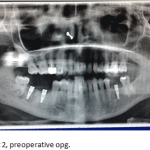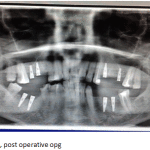Manuscript accepted on :
Published online on: 06-01-2016
Plagiarism Check: Yes
Vijay Ebenezer1 and R. Balakrishnan2
1Head of the Department, Department of Oral and Maxillofacial Surgery, Sree Balaji Dental College and Hospital, Bharath University, Pallikaranai, Chennai-600100 2Professor, Department of Oral and Maxillofacial Surgery, Sree Balaji Dental College and Hospital, Bharath University, Pallikaranai, Chennai-600100
DOI : https://dx.doi.org/10.13005/bpj/707
Abstract
In recent years, immediate or early implant placement after tooth extraction has becoming more common. Placement of an implant immediately after tooth extraction seems to offer several advantages without compromising the quality of results achieved by the conventional delayed implants. The present review focuses on the clinical outcome of immediate or early implant placement in 100 clinical cases. The study focuses on the success rates, stability, and bone augmentation procedures with immediate placed implants in fresh extraction sockets.
Keywords
Implants; Immediate placement; Osseointegration; autogenous bone graft
Download this article as:| Copy the following to cite this article: Ebenezer V, Balakrishnan R. Immediate Vs Delayed Implants: comparative study of 100 cases. Biomed Pharmacol J 2015;8(October Spl Edition) |
| Copy the following to cite this URL: Ebenezer V, Balakrishnan R. Immediate Vs Delayed Implants: comparative study of 100 cases. Biomed Pharmacol J 2015;8(October Spl Edition). Available from: http://biomedpharmajournal.org/?p=3542> |
Introduction
Placement of dental implants for replacing missing teeth is a well-established treatment option. According to the original protocol, it was state of the art to wait several months after tooth extraction before placement of the implants to allow alveolar bone healing. Along with the recommended load-free period of 3–6 months to ensure osseointegration of the implants, a long treatment period was an obvious drawback of this treatment modality1. This protocol has been challenged the last decades by reducing the time between extraction of a tooth and placing and ⁄ or loading of the implant2.
The immediate insertion of implants in fresh extraction sockets is a treatment modality shown to have high success rates3. Among its advantages compared to implantation in healed sockets include: reduced bone Resorption of the extraction socket, shortening of the treatment time, and avoidance of a second surgery4.
The surgical requirements include extraction that is as atraumatic as possible, maximum respect for the alveolar cortical bone and thorough socket curettage to remove all pathologic tissue5. Primary stability is a key requisite that can be achieved with an implant that exceeds the alveolar apex by 3 to 5mm or with an implant that is wider in diameter than the socket6.
After extraction of teeth, alveolar bone resorption may be so severe that if left uncontrolled, may lead to severe bone deficiency, which may in turn, even contraindicate the placement of an implant7. Immediate implant placement in fresh extraction sockets allow placement of implants during the same visit at which the tooth is extracted, which reduces morbidity and decreases treatment time, allow placement of implant in ideal position from the prosthetic point of view. It also helps to preserve the height of the alveolar bone and to avoid marginal bone loss that typically occurs during socket healing after extraction8,9.
The aim of this study was to evaluate efficiency and observe bone healing in 100 cases where immediate implants were in fresh extraction sockets post operatively after 6 months.
Surgical procedure for immediate implant placement
All patients were planned to be operated under local anesthesia with prior antibiotic 1 hour before the surgery. The tooth planned for immediate placement of implant was removed atraumatically as possible with the help of periotome with minimal mucoperiosteal flap elevation. With the help of pre operative X-ray the size of the implant to be placed is determined. The osteotomy was initiated with pilot drill following the sequence of drills. In maxillary teeth the osteotomy site was initially on the palatal wall of the socket while in the mandibular teeth the interdental bone is used, so that the implant achieves is initial stability and the future prosthesis is in center buccolingually and mesiodistally. The osteotomy is always extended beyond the apex of the socket of the extracted teeth, minimum 3 mm beyond. The osteotomy site is further enlarged and the final drill is done and the implant is placed. The implant is tightened with manual rachet, 45 N of torque achieved. The implant is in placed at the level of crestal bone. A cover screw was placed over the implant. The Space between the implant and the socket wall is filled with autogenous bone graft harvested for local site by bone trephine drill and then by the help of bone miller, the graft is particled and packed in the space. No membrane was placed over the bone graft, only primary soft tissue closure done over the implant.
Post operatively, the implants sites were inspected after 6 months clinically and radiologically. Implants sites were checked for any visual signs of inflammation, perimplantitis, plaque accumulation, mobility, gingival margin location, attachment level, and gingival width. Crestal bone height was measured radiographically. OPG were checked for any signs of radiolucency around the implant. Most of the immediate implants showed excellent osseointegration.
 |
Figure 1: Patient 1, pre operative opg |
 |
Figure 2: Patient 1,post operative opg |
 |
Figure 3: patient 2, preoperative opg |
 |
Figure 4: Patient 2, post operative opg |
 |
Figure 5: Patient 3, preoperative opg |
 |
Figure 6: patient 3, post operative opg |
Discussion
The clinical, anatomic, and radiologic characteristics of the socket immediately after tooth extraction are distinctly different from the socket environment after 1 year of healing10. Implants placed immediately in fresh extraction sites engage precisely prepared bony walls only in their apex, while the coronal space is filled by the end of the healing phase. Therefore, since the main difference occurs during the initial stage of osseointegration, most of the studies focus on this interval to define survival rates11.
The level of implant insertion into the alveolar crest is crucial, since its placement below the crest prevents bone preservation, one of the main advantages of immediate implantation. Crestal placement without radical alveoplasty is preferable, because it does constitute an impediment to desirable outcome.
The search for the ideal gap filling material is an ongoing process. The general impression one obtains from the literature is that autogenous bone grafts seem to be the best choice. The bone may be harvested from surgical bur debris, the lateral bone margins of the implant site, maxillary tuberosity, retromolar area, or the chin. In this study, autogenous bone graft was harvested from local site by bone trephine drill and crushed using bone miller and packed.
Atraumatic extraction technique is very important for the success of immediate implant placement as it helps to maintain the maximum amount of bone engaging the implant. Atraumatic extraction will allow for the preservation of buccal plate of bone (preventing its perforations or fracture) without which an immediate implant placement might be contraindicated. The study showed that immediate placed implants have a very high success rate of 95%. This was consistent with other studies done by Wagenberg et al, Rosenquist B et al, Schwartz-Arad D et al12,13,14.
Conclusion
This study demonstrates that it is possible to achieve greater efficiency in our efforts to give patient sound, timely and economical treatment. This procedure is still technique sensitive, but it is clear that with continued innovation in the prosthetic capabilities of implant system we should be able to enhance the service and treatment offered to our patients in regard to our treatment time, patient comfort, cost and aesthetics.
References
- Branemark P-I. Introduction to osseointegration. In: Branemark P-I, Zarb G, Albrektsson T, eds. Tissue-integrated prostheses. Osseointegration in clinical dentistry. Chicago, Berlin: Quintessence Publishing Co., 1985:11–76.
- Schropp L & Isidor F. Timing of implant placement relative to tooth extraction. Journal of Oral Rehabilitation 2008 35 (Suppl. 1); 33–43
- Quirynen M, Van Assche N, Botticelli D, Berglundh T. How does the timing of implant placement to extraction affect outcome? Int J Oral Maxillofac Implants 2007;22(suppl):203-23
- Botticelli D, Renzi A, Lindhe J, Berglundh T. Implants in fresh extraction sockets: A prospective 5 year follow up clinical study. Clin Oral Implants Res 2008;19:1226-1232
- Lindeboom JA, Tjiook Y, Kroon FH. Immediate placement of implantsin periapical infected sites: A prospective randomized study in 50 patients. Oral Surg Oral Med Oral Pathol Oral Radiol Endod 2006;101:705-710
- Chen ST, Wilson TG Jr, Hӓmmerle CH. Immediate or early placement of implants following tooth extraction: Review of biologic basis, clinical procedures, and outcomes. Int J Oral Maxillofac Implants 2004;19:12-25
- Atwood DA. Reduction of residual ridge: A major oral disease entity. J Prosthot Dent 1971;26:266-69
- Grunder U, Polizzi G, Geone R, et al. A 3 year prospective multicentre follow-up report on immediate and delayed immediate placement of implants. Int J Oral Maxillofac Implants1999;14:210-16
- Schwartz-Arad D, Chaushu G. The ways and wherefores of immediate implant placement into fresh extraction sites: A literature review. J Periodontol 68;915-23
- Becker W, Goldstein M. Immediate implant placement: Treatment planning and surgical stepsfor a successful outcome. Periodontology 2008;47:79-89
- Barzilay I, Graser G, Iranpour B, Natiella J, Proskin H. Histologic and clinical assessment of implants placed in extraction sockets. J Dent Res 1990;69.
- A Wagenberg B, Froum SJ. A retrospective study of 1925 consecutively placed immediate implants from 1988 to 2004. Int J Oral Maxillofac Implants. 2006 Jan-Feb;21(1):71-80.
- Rosenquist B, Grenthe B. Immediate placement of implants into extraction sockets: implant survival. Int J Oral Maxillofac Implants. 1996;11:205–209.
- Schwartz-Arad D, Grossman Y, Chaushu G. The clinical effectiveness of implants placed immediately into fresh extraction sites of molar teeth. J Periodontol. 2000;71:839–844.







